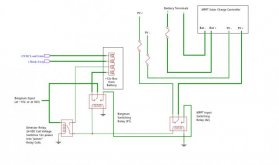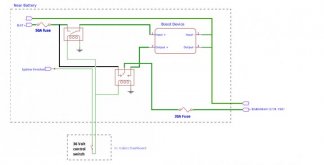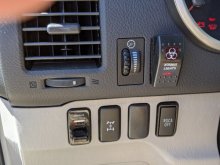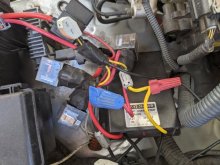I have posted comments which describe my "Charge LFP batteries from the TV" solution in another Thread already, but that Thread's Title does not do a good job of explaining how this gets put together, and why it's typically better than using a DC-->DC charger "solution". This repeats that information, with just another picture or two. But by separating this scheme into a Thread of its own, I hope to answer questions about THIS scheme exclusively, and avoid this design getting lost among a ton of store-bought DC-->DC implementations.
In Charging from a typical "Tow Vehicle", typically running at around 13.2-13.5 Volts after the starting battery is "charged, a high-powered "DC->DC charging solution" must dry high current (at low Tow Vehicle Voltage) through a long cable, which must either be (a) fairly large, not a Bargman cable; or (b) running at only very low power. The DC-->DC charger is responsible for matching battery requirements.
But if you already have solar panels and an MPPT SCC within the Trailer, the Battery Charge Voltage management which the DC--DC chargers Provide is REDUNDANT with the MPPT Solar Controller. I simply use a cheaper and larger Boost Converter/Regulator under the hood, sending only lower current into the MMPT through a Bargman connector at slightly more than 13A. My parts cost about $80, and reach up to about 440 maximum watts delivered from your existing MPPT into your battery string (30A @ 14.5V maximum charge Voltage). But you must limit your MMPT to that maximum current value, or else you will burn out the Boost Converte/Regulator which I use.
My system also has the limitation of forcing you to choose between "real Solar Panels" and the TV " virtual Solar Panel", they can't run at the same time. This is under the control of a dashboard switch, "enabling" 36.0 Volts on the Bargman "Trailer Battery Charge" wire. The hard part of an installation has always been adding that dashboard switch. The Trailer wiring is pretty simple, and the "normal versus boosted" circuit under the hood of the TV is fairly simple as well. With this design, the TV defaults to using "12-volt" battery charge - allowing you to tow normal trailers at any time. The Trailer automatically detects and switches, according to the presence of about 24 Volts (requiring a minimum of about 18 Volts to maintain the "hold-in" on the Detector Relay.) The "load terminal" current handling on the Detector is irrelevant, because it will only carry tiny amperage at 12V to drive the coills of other 12V Relays. (But those "Switcher" Relays do need to be capable of handling considerable current at moderately high Voltage, the "PV +" and "Virtual Panel +" inputs are both switched on the power terminals.
My "Detector" Relay is this one: https://www.amazon.com/Ehdis-Motor-Relay-40amp-Model/dp/B01J5CLJ0I/. It uses a 24V coil (a 28V or 32V coil would be more "optimal", but none of these have blown up while subjected to "36.0V" coil voltage in the trailer of myself and my friends.
In Charging from a typical "Tow Vehicle", typically running at around 13.2-13.5 Volts after the starting battery is "charged, a high-powered "DC->DC charging solution" must dry high current (at low Tow Vehicle Voltage) through a long cable, which must either be (a) fairly large, not a Bargman cable; or (b) running at only very low power. The DC-->DC charger is responsible for matching battery requirements.
But if you already have solar panels and an MPPT SCC within the Trailer, the Battery Charge Voltage management which the DC--DC chargers Provide is REDUNDANT with the MPPT Solar Controller. I simply use a cheaper and larger Boost Converter/Regulator under the hood, sending only lower current into the MMPT through a Bargman connector at slightly more than 13A. My parts cost about $80, and reach up to about 440 maximum watts delivered from your existing MPPT into your battery string (30A @ 14.5V maximum charge Voltage). But you must limit your MMPT to that maximum current value, or else you will burn out the Boost Converte/Regulator which I use.
My system also has the limitation of forcing you to choose between "real Solar Panels" and the TV " virtual Solar Panel", they can't run at the same time. This is under the control of a dashboard switch, "enabling" 36.0 Volts on the Bargman "Trailer Battery Charge" wire. The hard part of an installation has always been adding that dashboard switch. The Trailer wiring is pretty simple, and the "normal versus boosted" circuit under the hood of the TV is fairly simple as well. With this design, the TV defaults to using "12-volt" battery charge - allowing you to tow normal trailers at any time. The Trailer automatically detects and switches, according to the presence of about 24 Volts (requiring a minimum of about 18 Volts to maintain the "hold-in" on the Detector Relay.) The "load terminal" current handling on the Detector is irrelevant, because it will only carry tiny amperage at 12V to drive the coills of other 12V Relays. (But those "Switcher" Relays do need to be capable of handling considerable current at moderately high Voltage, the "PV +" and "Virtual Panel +" inputs are both switched on the power terminals.
My "Detector" Relay is this one: https://www.amazon.com/Ehdis-Motor-Relay-40amp-Model/dp/B01J5CLJ0I/. It uses a 24V coil (a 28V or 32V coil would be more "optimal", but none of these have blown up while subjected to "36.0V" coil voltage in the trailer of myself and my friends.






